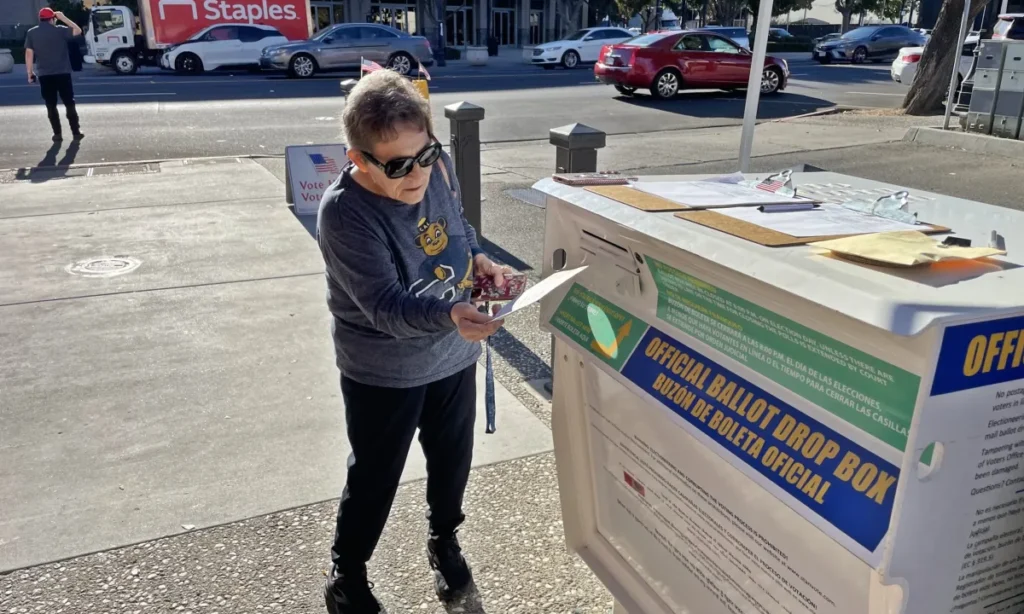The state is working on electronic benefit cards with security chips, but is behind schedule. Families are expected to be able to use them in January 2025. (AP File)

- New chip-enabled EBT cards in California delayed until early 2025, leaving recipients vulnerable to ongoing theft.
- State continues to lose over $10 million monthly in benefits theft, with $361 million stolen in the past three years.
- Delay attributed to complex technological changes and federal regulations. California aims for a smooth consumer-centered rollout.
Share
|
Getting your Trinity Audio player ready...
|
Californians will get cash and food assistance on more secure cards early next year — about six months later than promised, prolonging a massive recent theft wave that has been taking more than $15 million every month from the state’s poorest families.

Jeanne Kuang
CalMatters
New electronic benefits transfer cards that come with embedded microchips for security were originally supposed to go out to families this summer. They’ve been delayed, said state Department of Social Services spokesperson Theresa Mier, “due to the complex technological changes required.”
When finally rolled out, California would become the first state to equip EBT cards with a commonplace level of fraud protection available to debit and credit card users since 2015. The state budgeted $50 million for the EBT system upgrades last year.
Across the country, low-income recipients of cash aid or the Supplemental Nutrition Assistance Program (formerly known as food stamps) get the benefits loaded each month on cards that have little more than a magnetic stripe.
That makes them particularly vulnerable to thieves, who use hidden “skimming” devices at ATMs, grocery store payment terminals and gas pumps to steal users’ information when they swipe the magnetic stripes, then drain their accounts. Law enforcement officials in Los Angeles and elsewhere have tied some of the thefts to international organized crime rings.
California Hard Hit by EBT Theft
California, with its large population and more generous social safety net policies, has been particularly hard hit.
The thefts have left low-income families waiting extra days or even weeks for their full CalFresh and CalWORKs benefits. At times, they’ve gone hungry, delayed rent payments and shouldered late fees. In Los Angeles County alone, the thefts affect thousands of families a month.
Related Story: Millions of Californians Have Medical Debt. It Wouldn’t Hurt Your Credit ...
Reported thefts are falling this year from a January peak of $20.8 million, according to Department of Social Services data, but California continues to lose more than $10 million a month. In the three-year period that ended in August 2024, low-income Californians have reported $242 million in cash aid and $119 million in food benefits stolen.
While the benefits are federally funded, the money to reimburse victims has come from California taxpayers. Recipients are fully reimbursed for CalWORKs payments, and one month at a time for CalFresh benefits.
Feds Nearly Done Replenishing Stolen Benefits
For the past year, the U.S. Department of Agriculture has provided much of the money to replenish stolen food benefits, and given some of those victims bigger reimbursements. When that provision expires at the end of the month, California will go back to footing the entire bill.
The new cards are still expected to have a magnetic stripe that users can swipe as a “fallback” option. But inserting a chip card is much safer because the chips encrypt account information.
Mier would not say when exactly the new cards will be mailed out, and did not respond to an interview request. Anti-poverty advocates and the California Grocers Association said they’re preparing for a rollout in January.
The delay was partially due to federal regulations which, the state told CalMatters last year, directed states to use a payments industry standard that limits them to cards with magnetic stripes only.
To make sure grocery stores and other retailers can process transactions on EBT cards with chips, the state had to wait for the U.S. Department of Agriculture and the payments industry to update that standard, said grocers association spokesperson Nate Rose. That didn’t happen until August.
Related Story: U.S. National Debt Tops $35 Trillion for First Time
Without that step, Rose said grocers couldn’t update their payment systems software to ensure they could read EBT chip cards, which are handled differently from commercial credit and debit cards. Grocers are now making the updates and testing out sample chip cards, he said.
“It’s in everyone’s best interest to make sure this works smoothly,” he said.
Andrew Cheyne, managing director of public policy at GRACE End Child Poverty in California, said the delay is worth it if it helps ensure low-income recipients aren’t using new cards that don’t work.
“We know many cardholders who don’t speak English, have disabilities, are unhoused, who may miss their card when it’s mailed out to them, or need help activating their new card,” Cheyne said. “We need a consumer-centered rollout.”
About the Author
Jeanne Kuang is an accountability reporter who covers labor, politics and California’s state government. She focuses on how well officials follow through on laws, such as indoor heat protections for workers, a higher minimum wage for fast food employees and a second chance for those convicted of crimes.
About CalMatters
CalMatters is a nonprofit, nonpartisan newsroom committed to explaining California policy and politics.
RELATED TOPICS:
Categories




















